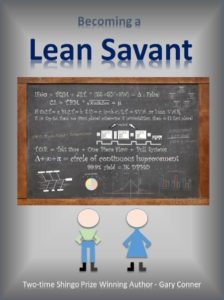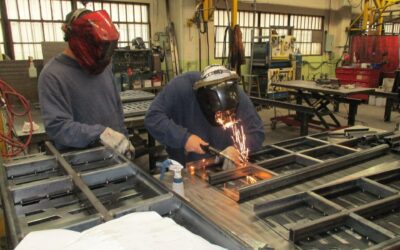
Two time Shingo Prize winner Gary Conner recently published his latest book, ‘Becoming a Lean Savant’. Gary is a veteran consultant having spent thirty years consulting to over 350 companies and facilitating more than 1500 project across the US and Canada. He has worked with manufacturers in virtually every industry teaching them how to adopt and adapt elements of the Toyota Production System. You may know Gary from his bestselling book Lean Manufacturing for the Small Shop. Recently, Gary published his new book, Becoming a Lean Savant Here is our interview with the one and only Gary Conner!
How did you become a consultant?
I have been consulting since 1995; stumbling into it by accident. While working at a sheet metal shop in what is now the Chemeketa Technical Center, our company began to adopt lean principles in 1986 at the demand of our biggest customer (Tektronix). Eventually, I traveled to Japan to learn more. It was there I picked up key continuous improvement principles and tools such as 5S, elimination of waste, and one piece flow.
I came back and helped implement what I learned. What I didn’t know at the time is that I was implementing continuous improvement in one of the most difficult environments – a union shop.
Our initiatives worked, and we became one of the first companies on the west coast who figured out how to deliver made-to-order products ‘just-in-time’. A few years later I was invited to tell our story at Westec (international machine tool show), and soon other companies asked me to teach them how to implement lean in their facilities. So, I began to organize tours and training.
Tom Neilson, my boss at the time, gave me permission to continue my training of other companies a week at a time every month. I did that for a year and realized I liked it. I was getting busier. The following year I taught every other week. Finally, I decided to go full time. To his credit, Tom was supportive and encouraging.
Sadly, Tom sold his company off because he did not have anyone to whom he could pass on his business. This is a great reminder of the importance of planning your business exit.
What drove you to write Becoming A Lean Savant?
When I wrote “Lean Manufacturing for the Small Shop in 2001, I left many lessons and ideas unsaid. In that first book, I answered the questions of what, why, when, and where, but not how. For example: how do you actually value stream map a high mix low volume environment?
There is nothing new under the sun, and there are 500 books on lean out there
If you’re an OEM there are plenty of books that fill that need. One of the best handbooks I’d recommend is called Learning To See. If you make one product all day long there’s really no improvements to be made to the ‘learning to see’ methodology.
None of those books address how to pace a high-mix, low volume environment
How do you pace a manufacturing system when the product has significant differences in labor content? If one part takes 10 min to product, and the next part takes half a day – it’s challenging to determine a takt-time (rhythm). None of the current books answer this fundamental element of the lean approach directly. This book is my attempt to provide those answers.
What do you hope readers will learn from Becoming A Lean Savant?
 I tried my best to put the collective experience of 350 client companies onto paper, and provide readers the tools to begin their own transformation.
I tried my best to put the collective experience of 350 client companies onto paper, and provide readers the tools to begin their own transformation.
I want to be a guide, to help readers know what they don’t know.
This isn’t just a book – it is a toolkit. Readers get access to 10 gigabytes of data – tools, worksheets, templates, and more that are discussed in the book.
I want to give you the ability to expand your toolbox. There are over 160 tools in the lean toolbox. Most people are generally aware of only about ten.
To be clear, I do not consider myself a lean savant (at least not yet), but I am on a personal journey to become the best I can be at applying the many tools and techniques discovered and perfected over the past one hundred years since Henry Ford put together his first balanced assembly line. This book represents my efforts to document an easy to understand, comprehensive and practical tool for those seeking to advance their organizations toward their vision of Operational Excellence.
In this book I attempt to answer the questions; Why, What, When, Who, Where and How organizations of every size and description can apply lean principles.
What else do you want readers to know?
I am living proof that manufacturing can change lives and that mentorship works.
I grew up in poverty, my family (7 brothers and sisters) lived on Government assistance after my father broke his neck in an industrial accident. I went into manufacturing because I could make a living wage without taking on school debt. During my time as a manufacturer, I was mentored by incredible people who cared about me, and I took every opportunity to grow my skills and knowledge.
At first, I was a naysayer about lean. I didn’t think it could work. However, lean continues to change my life for the better today. I think my story shows that manufacturing is an excellent career choice. It levels the playing field, giving everyone who works hard and who is willing to learn the chance to succeed. My story is also a great reminder for employers that providing employees growth opportunities is life-changing. and enormously beneficial to a business.
What was the process of writing your book?
It took a long time! I worked on this for about two years. I storyboard all my work, and taking a page from Steven King’s playbook, I try to be disciplined to write a few pages every day.
Are there any stories in the book you’d like to share?
I began working with a tow truck company who was considering shutting their plant down and moving operations to Mexico. They’re profiled in the book. The company couldn’t get enough trucks out the door on time. When I started working with them, they were making 4.5 trucks a month. We worked together to eliminate waste, and significantly changed their assembly process. Now, they’re making 12 a month with the same number of people. It has been transformative for their business and kept them here in the United States.
Where can readers learn more about your book?
For more information or to purchase Lean Savant click here.



